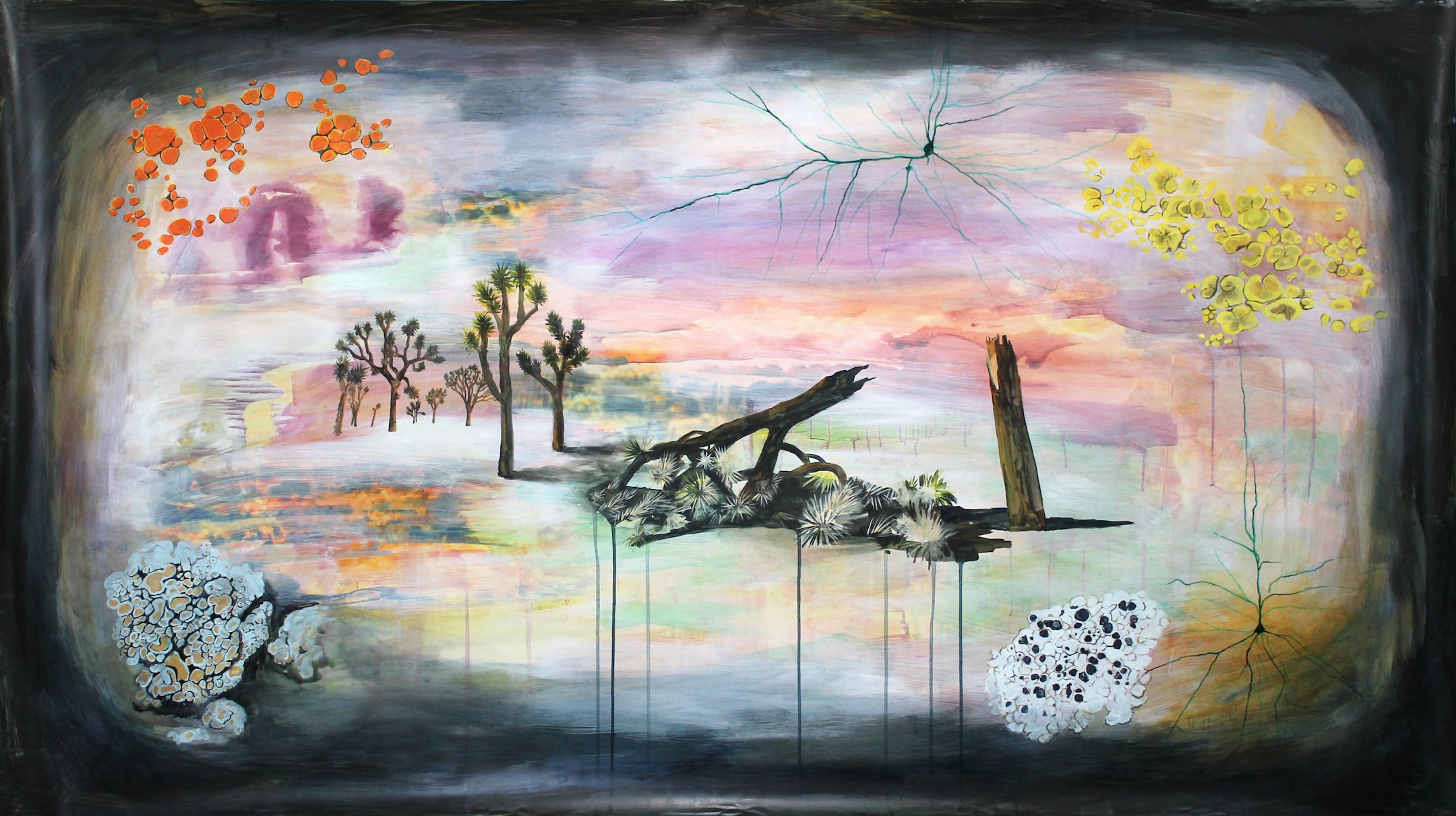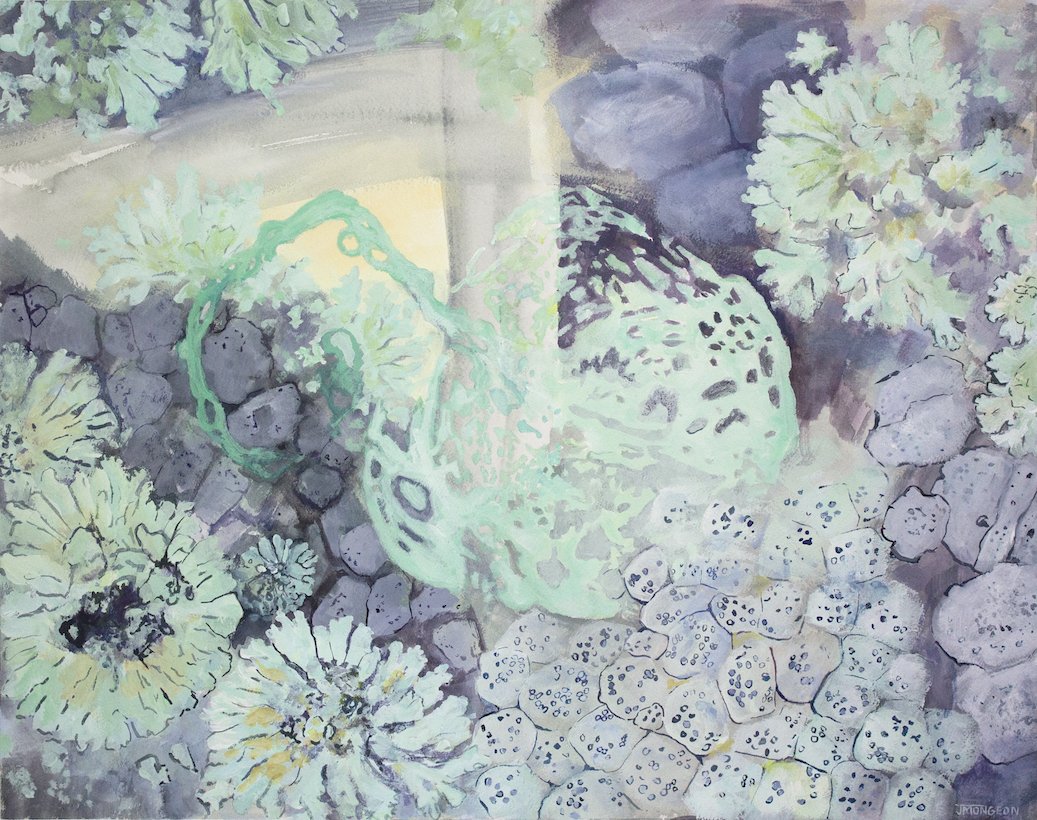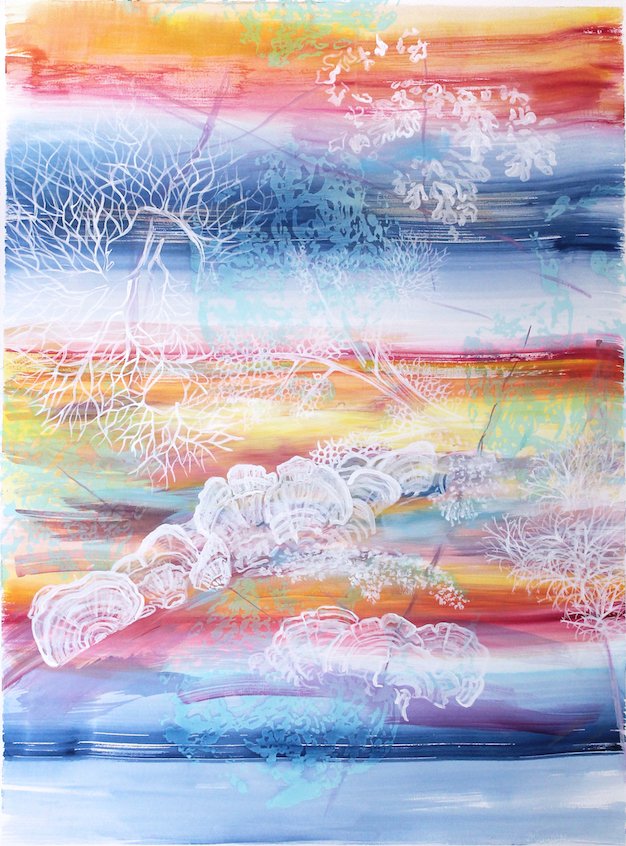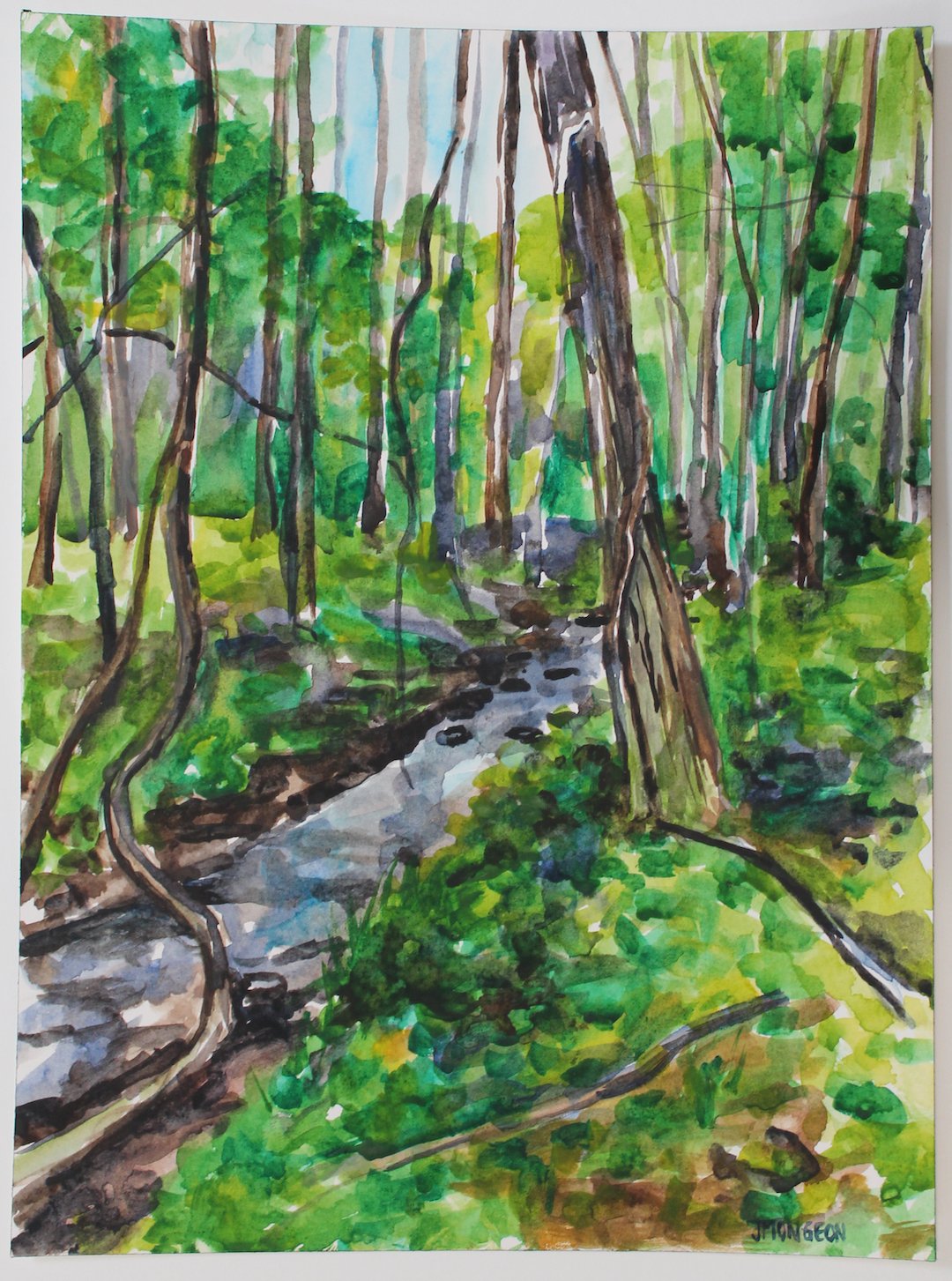Interview with artist Jessica Mongeon
Jessica Mongeon, originally from North Dakota, moved to Russellville, Arkansas in 2016 to begin teaching art at Arkansas Tech University. She is an Assistant Professor Art and Foundations Coordinator. Jessica’s art practice explores how the human experience can impact nature and the environment. To achieve this, she uses vivid colors and mysterious settings to reveal unexpected ecosystems. More of Jessica’s work can be found at Art Ventures in Fayetteville and at her website jessicamongeon.com.
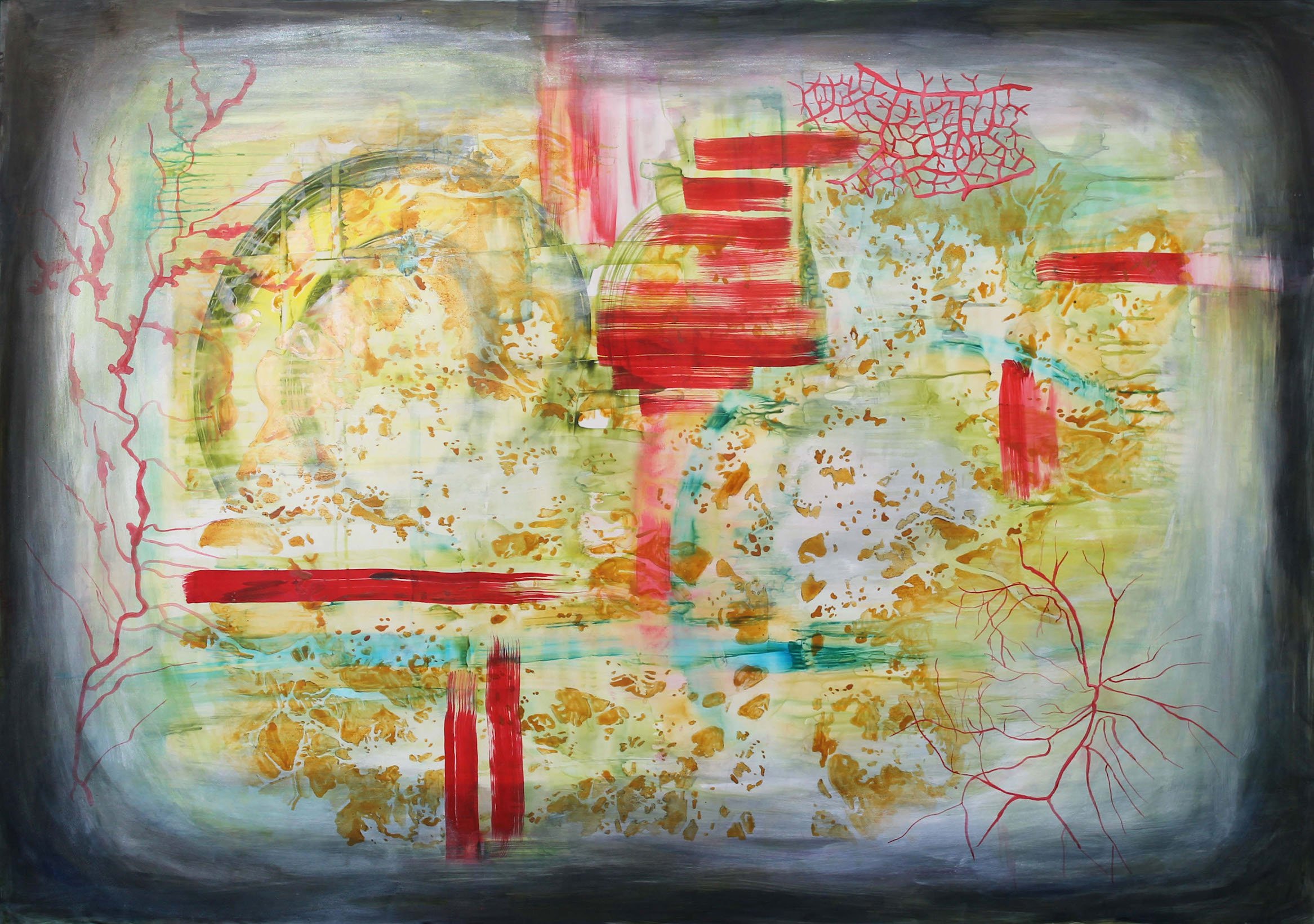

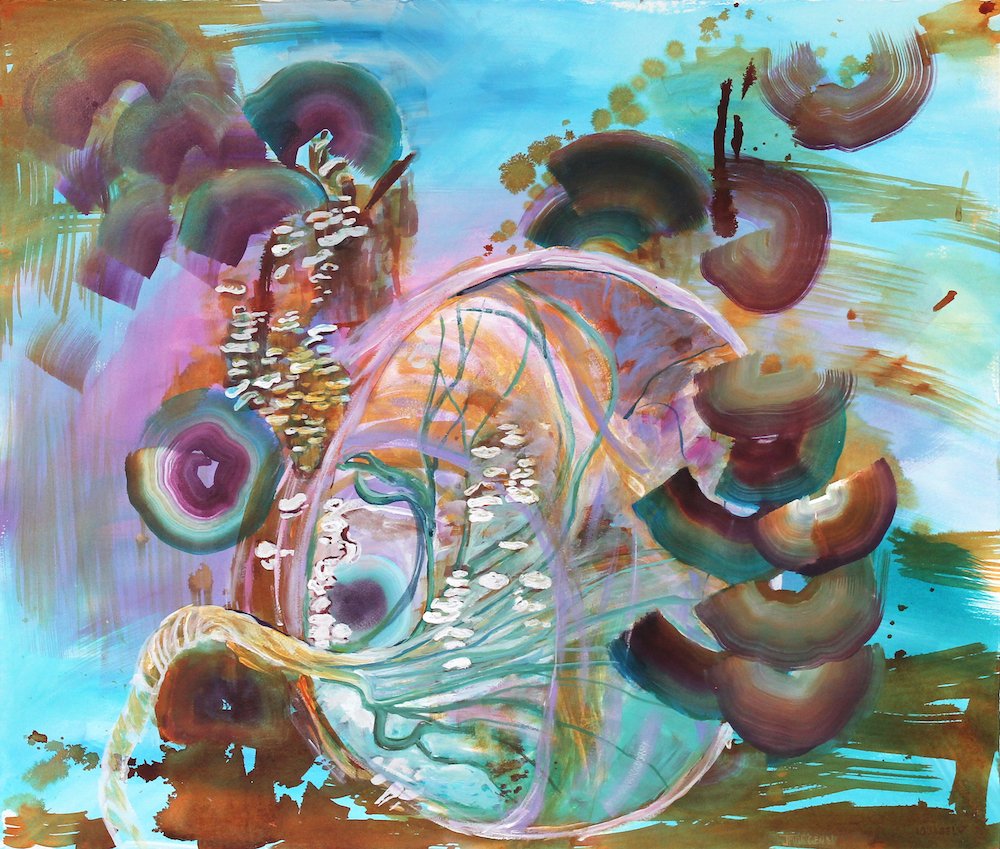

AAS: Jessica what brought you to Arkansas Tech University?
JM: I was searching for teaching jobs at universities in the area of fine arts and one of the places that I applied was Arkansas Tech University. I ended up getting hired as a visiting assistant professor, which turned into a Tenure-track position. I have an MFA in Painting from Montana State University in Bozeman, Montana, and I double majored at my undergraduate program with a BFA in Fine art, and a BA in Communications (Public Relations) and Honors. I decided to double-major because I was concerned about finding a job in the arts, and making money, but I decided to pursue it in the end because it’s my passion.
AAS: Where you exposed to art growing up? Did you have any role models who were artists?
JM: My interest in art was encouraged by my family from a young age, I wanted to be an author/illustrator because I loved books. I took art class in school, our art teacher also taught Spanish, she taught the art classes for the entire school from K-12. I also took some private art lessons in Mrs. O’Malley’s basement in a nearby town, she was from Ireland, and I believe she moved back since then. That was in Junior high and I learned how to draw in pastel and oil paint from her. I showed my artwork in 4-H at the county and state fairs. Other than that, I wasn’t exposed to much art, I grew up on a farm in rural North Dakota. My grandparents were portrait photographers, and my grandmother on my mom’s side of the family was a painter.
AAS: As Assistant Professor of Art you teach a lot of classes. Was teaching something you always thought you wanted to do?
JM: I didn’t want to become a teacher at first, I was worried there wouldn’t be time to create my own work. But when I went to the University of North Dakota, I was inspired by the professors that taught me and I thought they had pretty great lives. I loved college, the best part was that in the art classes everyone wanted to be there and took it seriously. I loved art school so much that I wanted to keep going, so I went to grad school. I knew I wanted to teach at the university level at that point and I had the opportunity to teach while I was a grad student, so that was great experience and gave me an idea about what a career as an art educator in higher education would be. My main goal was to be able to keep making my artwork, so I found a career that supported that goal. It’s part of my job to be a professional in my field and do research, that means to continue to create and exhibit artwork. Sometimes the teaching and administrative duties take over and I don’t have as much time for my own work, but it goes in cycles. I get most of my painting done over the summer.
“I feel refreshed and grounded after being in nature, simply walking through and appreciating a place. That openness allows me to find unusual connections; it’s about sharing a sense of wonder and appreciation for the beauty and complexity of life.”
AAS: You’ve said your art explores the relationship between humans and nature. Did this intent develop over time, or have you always explored this connection?
JM: Yes, it evolved over time, when was a student in North Dakota my work was all about horses. They were abstract horses and I thought about them as the bridge between humans and nature. After I graduated, I worked on some more abstract, landscape-based work. Having grown up in North Dakota the wide-open landscapes influenced my work. In graduate school my work was based on hiking in nature and my experiences in the mountains, each time I move to a new location my work changes. So, it’s about my relationship with nature and place. I enjoy hiking and used to be into backpacking when I lived in Montana. For me it’s about more than enjoying pretty views, I love the sense of discovery and capturing those discoveries to create something new in the studio. I feel refreshed and grounded after being in nature, simply walking through and appreciating a place. That openness allows me to find unusual connections; it’s about sharing a sense of wonder and appreciation for the beauty and complexity of life.
AAS: Lichens and fungi are elements in many of your most recent works. Forest Bathing is one of those. Would you talk about that piece?
Forest Bathing, 48” x 36”, acrylic on canvas
JM: I started the lichen-neuron series when I lived in Wisconsin, the landscape wasn’t sweeping and dramatic like the Rocky Mountains of Montana. I noticed the small things like lichen and mushrooms in the forests. That’s when I started thinking about the similarities between nature and human biology. Neurons symbolize consciousness, an awareness of one’s surroundings. They show a connection between humans and nature because of their tree-like branching quality. Neurons connect and communicate to keep the mind and body alive. Similarly, lichen is made of a fungus, an alga and sometimes a yeast that work in symbiosis. I was reading about fractals, which are repeating patterns found in nature. I’m hoping people make the connection that they are a part of nature even at the microscopic level. I enjoy depicting microscopic parts of the human body because they aren’t the obvious parts that we see when we picture a person. It is in those unseen parts of ourselves where we can find the networks and connections that are in sync with nature.
Forest Bathing is a more abstract than my lichen-neuron series. It’s named from the Japanese practice that involves going into the forest as a meditation practice to benefit your mental and physical health. The mushroom forms are abstracted into circular brushstrokes, which become more about the gesture and could be many things. I’ve had people say they look like geodes too. I like that people can interpret it different ways. Something that you don’t realize when you see the work online is that it has some actual texture from the absorbent gesso I applied.
I want people think about their own experiences with nature. I’m worried about the impact of humans on the environment, and I want my work to change people’s perspectives. Rather than depicting destruction, like strip mining or pollution, I am highlighting the wonderful things about nature and our place in it. I use color to speak to viewers on a visceral and emotional level rather than using words or complete representation. This is my gentle form of environmental activism. I want to convey a sense of hope because the climate future seems bleak and if we don’t have hope we won’t try to improve things.
AAS: Another wonderful piece from that series is I Found Myself Within a Forest Dark. What I really like about it is the color palette. It is very magical, which helps explore the theme.
JM: The title of this painting is inspired by “The Divine Comedy” by Dante Alighieri because it speaks to the faults of humankind that have prevailed for centuries. “I Found Myself Within a Forest Dark” is named after a phrase in Canto I of “Inferno,” which is based in a forest with a dreamlike atmosphere. I included imagery of two types of neurons found in the human brain. I was going through a difficult time in my life, so that’s why it ended up being a darker color scheme. It also has some iridescence, the white that I applied to create a foggy effect has some sparkle. The dark border reminds me of the edges of consciousness, it creates a vignette effect. The trees are part of an old growth forest that I photographed while hiking at Mount Magazine State Park and the club moss and lichen are from that same hike.
There are very few old growth forests left in Arkansas, so this felt like a special place of transformation and healing for me. The painting has many layers, with colorful drips in the background that are obscured by a fog and layers on top of it. It’s about going into nature to sort through your feelings and figure out where you are going next.
I Found Myself Within a Forest Dark 40” x 71”, acrylic on stone paper
AAS: You have another series called Origins. Would you talk about that series and the piece Lifecycle?
Life Cycle, 16” x 20”, acrylic gouache on Arches paper
JM: This series, Origins, was inspired by pregnancy, childbirth, and motherhood. Becoming a mother was a profound and challenging experience for me, especially since it happened during the height of the pandemic. After my son’s birth, I made direct prints of the placenta and umbilical cord by pressing them onto pieces of paper. I then traced the print to create a silkscreen. Since I traced the image from the original, the resulting prints are life-size. In a birth class I learned that the wound in the mother’s uterus from where the placenta was attached is the size of a dinner plate; that’s why it’s important to rest. That stuck with me. The placenta and umbilical cord symbolize the physical connection between mother and child, and the act of cutting the umbilical cord begins the process of a child becoming their own person. The placentas are camouflaged with lichen, mosses, and mushrooms in an imaginary environment. In Life cycle I included the placenta prints symbolizing the beginning of life in the background, and rainbow bracket fungus in the foreground appear almost as flowers. Mushrooms relate to the end of life; they break down wood from trees to create soil, which provides nutrients to new organisms, thus continuing the cycle of life.
Even though I talk about a lot of serious issues regarding birth that relate to this series the overarching theme is more joyful. Bringing a new life into the world was wonderful and transformative. A couple of the paintings in Origins have my son’s footprint in paint hidden in the imagery so I think of it as a collaboration with him. In becoming a mother, I experienced my body and connection to nature in a completely different way, and I wanted to speak to that; it’s my most personal series.
The Source, 26” x 26” (8” x 8” sections), acrylic on cradled wood panel
The Source is painted from a photo I took of my placenta, I changed the colors and abstracted it, but the proportions are accurate. It’s this organ that my body grew to feed my child, it’s a natural process but also strange, how many times do you see one of your own organs outside of your body? I painted on multiple small wood panels that come together to create the full image. I was thinking about how some mother’s end up with a retained placenta, which means part of the placenta doesn’t detach and it can become infected. Having a child is powerful but it is also dangerous. This series isn’t for mothers only, everyone has been born so it’s an experience we all share. I don’t think people always appreciate what mothers go through to bring a new human into the world, I certainly didn’t before I went through it myself.
AAS: Teaching at the college level, raising a family, and being a successful artist has got to be especially challenging. Earlier this year you were asked to participate in a panel discussion on just this topic hosted by the University of North Carolina, Charlotte. What did you learn from that experience?
JM: The conference was held virtually, normally it was in-person. It made it easier to attend because I didn’t have to worry about childcare. FATE is an organization for educators that teach art Foundations, which are the introductory classes to prepare students for their upper division classes in art or design. My talk was called “Balance is a Myth: Riding the teeter totter of full-time parenting and teaching online.” It was about how it’s unrealistic to expect balance when there are so many competing obligations. Rather than striving to achieve balance as the end goal, accept that in certain seasons of life, different elements will be heavier. For me the key was to prioritize what needed to be done and work in short bursts of productivity.
Last year wasn’t a normal time, many people were operating in crisis mode (and many still are). I taught online during Fall 2020 and Spring 2021, and I had my son at home because we didn’t feel like it was safe to put him in daycare because of Covid-19. Like many others, I spent the Summer of 2020 creating online versions of my classes, for me that was the key to success because I had time to prep for the semester. I was spreading out the workload so that it would be easier when the semester started. My spouse also worked from home, so he was able to take our son when I had class.
Napscape #3, 20” x 16”, acrylic on paper, Ozark-St. rancis Forest near Spy Rock Trail
When my son was a newborn, I felt a loss of identity because I didn’t have any time or energy to paint or do the activities that I used to enjoy. I felt better when I started making artwork again. I painted a series of watercolor landscapes that were completed during naptime, I call them “Napscapes.” They are based on places that I’ve hiked in Arkansas. Even though I couldn’t get out of the house, I had a sense of escape. Since then, I’ve made time to create work, the next series I started was Origins. This semester I am back to teaching in-person full-time and we have childcare, so life is more manageable.
Mind Forest, installation approximately 8’ x 10’ x 4’, acrylic on stone paper
AAS: I want to ask you about your installation, Mind Forest, which is an explosion of color. It is spectacular! And must have been fun to create?
JM: It was fun to create. I wanted to create a 3-D version of a painting, one that you could walk into, which is more like experiencing nature. The circular forms are loosely based off mushrooms and the larger forms are tree stumps. I worked from photos of tree stumps that I discovered in various stages of decomposition. They are depicted with vivid colors to highlight the essential role they play in the cycle of life. While the trees are no longer alive, they become hosts for fungi, microbes and insects that break them down into nutrients that other plants will use. The hanging elements remind me of leaves, they move and rotate.
10. AAS: You have exhibited in many solo and group shows. One very recently was at at 211 South in Bentonville with Steven Wise, who I interviewed a few weeks ago, and was curated by Kellie Lehr, who I also interviewed. Exhibiting your work is also a way to show your students not to be self-conscious about letting the public see their work.
JM: Yes, you have to put your work out there so that people can see it, preferably in-person. Steven and I both do landscape painting based on places on Arkansas, even though the series I showed was my “Origins” series. I encourage students to apply for many opportunities. Rejection is part of the process. Often for juried shows it’s not that the work wasn’t as good, it just didn’t fit into the theme or vision that the juror has. While the act of creating work is satisfying, my goal is for people to see it, and in some cases to collect it for their homes so that it can be a part of their lives.
